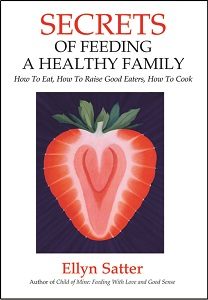

Family Meals Focus
The Ellyn Satter Institute Newsletter
Eating competence: Context-management skills
by Ellyn Satter, Dietitian and Family Therapist
For a PDF of this newsletter, click here
You have good food context-management skills when you do a good job with managing structure and therefore taking good care of yourself with food. You plan for feeding yourself, you take time to eat, and you tune in when you eat. You don’t just grab food when you get hungry.1 People with high eating competence use a lot of strategies to see that they get fed: They cook from scratch, cook using convenience foods and convenient ingredients, order out, take out, and eat out.
Reassure yourself that you will be fed
Our research shows that people who have high overall eating competence scores, and particularly those who have high food context scores, efficiently plan, cook, shop, and manage their food money.2 The point of having food context skills is reassuring yourself (and your family) that you will be fed. As I have told you before in this ecSatter series, people with high eating competence experience little of the misery that can surround eating. They are relaxed about eating, relatively satisfied with their bodies, and put the emphasis on food seeking rather than food avoidance. Low income people who have good food context skills are less likely to see themselves as being food insecure.
Structure makes eating fall into place
Structure + food acceptance skills =
Variety and therefore positive nutritional status
Structure + food regulation capabilities =
Energy balance and therefore constitutionally appropriate body weight
You gotta have meals – and snacks
To reap the rewards of trustworthy, satisfying, internally regulated eating, you must provide yourself with regular, reliable, rewarding meals as well as sit-down snacks if you need them. To be able to trust your body to help you with the what and how much of eating, you must provide it with the support it needs.3 You will do a good job with eating as much as you need of a variety of food if you reliably feed yourself, go to some trouble to make food taste good, and take the time to tune in and enjoy your food. On the other hand, you won’t do a good job with the what and how much of eating if you are casual about feeding yourself, grab food only when you happen to think about it or when hunger drives you to it, absent-mindedly snack and nibble instead of taking time to feed yourself, or chronically restrict yourself.
Feed yourself faithfully
To trust your body to help you with the what and how much of eating, you must provide it with the support it needs.
The trick is being disciplined without becoming negative. There is positive discipline in feeding yourself well. It takes discipline to set up regular and predictable mealtimes, to plan the shopping list, to get the food in the house, to do the cooking and cleanup, to set aside the time to eat, to tune in when you are eating, the list goes on. On the other hand, the discipline becomes negative when you get caught in the shoulds and oughts: what to eat, what to avoid, how much to eat. ”I must eat it because it is good for me.” ”That is way too fattening.” ”I mustn’t let it go to waste.” (Insert your guilt trip here.)
Think strategy, not dos and don’ts
When you think of meal planning, think strategy, not rules. The primary task is to develop the meal habit. Once you get the meal habit, your body will adjust by getting hungry just before it is time to eat. Start by getting the structure of meals well in place. Build meals based on what you and your family currently eat, and cluster those foods into meals and snacks. Do you cook up a box of macaroni and cheese or Tuna Helper to feed the children? Make enough for everyone, put out a plate of bread and butter and a carton of milk, sit down together and all share the same food. Eaters can generally manage bread and butter if all else fails. If drinking milk turns your meal into a chore or a bore, start by drinking what you drink. Do you order out for pizza and leave it on the kitchen counter for everyone to help themselves? Arrange to have it delivered at mealtime, then sit down together to eat it.
Expand your menus – but take your time
After you get used to the idea of structure, it is safe enough to gradually expand your menus. In fact, structure more-or-less triggers filling in the blanks with menus: opening a can of fruit, throwing together a salad. Be careful, however, that you don’t bring pressure to eat to the table along with new food. Follow the Satter Division of Responsibility is Feeding: You do the what, when, and where, other family members do the how much and whether. Also remember, the bottom line is pleasure. To keep up the day-in-day-out effort of structured meals, those meals must be richly rewarding to plan, prepare, provide and eat.
References
1. Satter EM. Eating Competence: definition and evidence for the Satter Eating Competence Model. J Nutr Educ Behav. 2007;39 (suppl):S142-S153.
2. Lohse B, Satter E, Horacek T, Gebreselassie T, Oakland MJ. Measuring Eating Competence: psychometric properties and validity of the ecSatter Inventory. J Nutr Educ Behav. 2007;39 (suppl):S154-S166.
3. Satter EM. Nutrition education with the Satter Eating Competence Model. J Nutr Educ Behav. 2007;39 (suppl):S189-S194.
Explore
Ellyn Satter’s Secrets of Feeding a Healthy Family says the secret of raising a healthy eater is to love good food, enjoy eating, and share that love and enjoyment with your child. When the joy goes out of eating, nutrition suffers.

